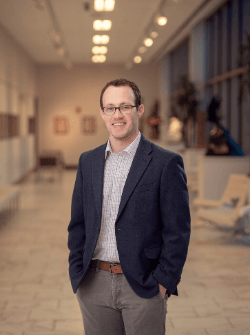 Dr. William Smith, who recently joined the Gilcrease Museum team with a rich background in history and a clear vision for furthering the mission of the Helmerich Center.
Dr. William Smith, who recently joined the Gilcrease Museum team with a rich background in history and a clear vision for furthering the mission of the Helmerich Center.
What’s your hometown?
I was raised in Marlow, a small town in southwest Oklahoma. I lived in Norman, Oklahoma, and South Bend, Indiana, for several years. More recently, I am coming to the Helmerich Center/Gilcrease/TU community from Stillwater, Oklahoma, where I worked at Oklahoma State University in the College of Arts and Sciences.
What is your educational background?
I have a bachelor’s degree in letters and a master’s degree in history from the University of Oklahoma, and both a master’s and a doctoral degree in history from the University of Notre Dame. I am endlessly fascinated by all history, but my specific research interests are in early American history, religious history, epistolary culture and the Atlantic world. My dissertation focused on Protestant letter-writing networks and the growth of empire around the British Atlantic world from roughly 1688 to 1756.
What sparked your interest in history?
History always appealed to me growing up, but I think it really comes down to having great history teachers in my life. My grandmother was interested in history and often watched historical documentaries with me, told stories about our family’s Cherokee heritage and took me to museums as a child, where history first came to life for me. I entered college intending to study music, but I quickly changed my major after taking a “U.S. History to 1865” course with an incredible historian. It was in that class where I began to appreciate the dynamism and power of history (and the humanities, generally). Learning that history, as E.H. Carr once put it, is an “unending dialogue between the past and the present” opened up a new way of thinking for me. It was exciting, empowering and inspiring to realize that the stories we tell about our American past both informs and is informed by the present. I read the works of wonderful historians whose books I admired and I discovered that this unending conversation shapes who we are and how we think about ourselves and others. I found all of this very compelling and, I guess you can say, the rest is history!
What brought you to the Helmerich Center for American Research?
The Helmerich Center combines many of the things that I love, including American history, research, teaching and scholarly community. Much of my professional work to this point had focused on undergraduate research and education, particularly helping college students discover and become researchers themselves. After hearing about this position, I was amazed to learn about the vast holdings at the Helmerich Center, from its Spanish colonial documents to 20th-century Americana. It’s thrilling to think about the possible stories we can help researchers uncover and share about the Americas, especially within a collection that covers such a large chronology and geography. In conjunction with The University of Tulsa and Gilcrease, the Helmerich Center for American Research is a special place full of great people doing meaningful work. I’m delighted to join this community.
What do you hope to accomplish as assistant director of the Helmerich Center for American Research
Given the Helmerich Center’s unique relationships to Gilcrease and TU, I want to build upon the institutional vision of making this center a hub of scholarly exploration, ideas, community and conversations. Having been here only a short time, I have already heard guest researchers exclaim about our significant collections, “I had no idea this was here!” I am committed to enhancing the national and international reputation of the Helmerich Center (and thereby Gilcrease and TU) as a place of interdisciplinary discovery. Partnering with our great team here, we plan to continue digitizing more of our collections so we can help people explore at a distance. I look forward to representing the Helmerich Center at professional conferences across scholarly disciplines to encourage more applications for our Duane H. King Postdoctoral and short-term fellowships, as well as our travel grants. By accomplishing these things, we can give the Helmerich Center a more visible presence (digitally and face-to-face) and invite scholars to participate in the life of our center. I am also committed to strengthening and expanding our relationships with TU faculty and students through our faculty-led seminars, lectures and symposia, but I also hope we can expand these offerings. Another priority for me is to develop more ways for TU undergraduates to connect with the Helmerich Center through research, workshops, internships and other programs. Stay tuned!